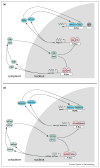Circadian timekeeping and output mechanisms in animals
- PMID: 23731779
- PMCID: PMC3973145
- DOI: 10.1016/j.conb.2013.02.018
Circadian timekeeping and output mechanisms in animals
Abstract
Daily rhythms in animal behavior, physiology and metabolism are driven by cell-autonomous clocks that are synchronized by environmental cycles, but maintain ∼24 hours rhythms even in the absence of environmental cues. These clocks keep time and control overt rhythms via interlocked transcriptional feedback loops, making it imperative to define the mechanisms that drive rhythmic transcription within these loops and on a genome-wide scale. Recent work identifies novel post-transcriptional and post-translational mechanisms that govern progression through these feedback loops to maintain a period of ∼24 hours. Likewise, new microarray and deep sequencing studies reveal interplay among clock activators, chromatin remodeling and RNA Pol II binding to set the phase of gene transcription and drive post-transcriptional regulatory systems that may greatly increase the proportion of genes that are under clock control. Despite great progress, gaps in our understanding of how feedback loop transcriptional programs maintain ∼24 hours cycles and drive overt rhythms remain.
Copyright © 2013 Elsevier Ltd. All rights reserved.
Figures



References
-
- Hardin PE, Hall JC, Rosbash M. Feedback of the Drosophila period gene product on circadian cycling of its messenger RNA levels. Nature. 1990;343:536–540. - PubMed
-
- Peschel N, Helfrich-Forster C. Setting the clock — by nature: circadian rhythm in the fruitfly Drosophila melanogaster. FEBS Lett. 2011;585:1435–1442. - PubMed
Publication types
MeSH terms
Grants and funding
LinkOut - more resources
Full Text Sources
Other Literature Sources

